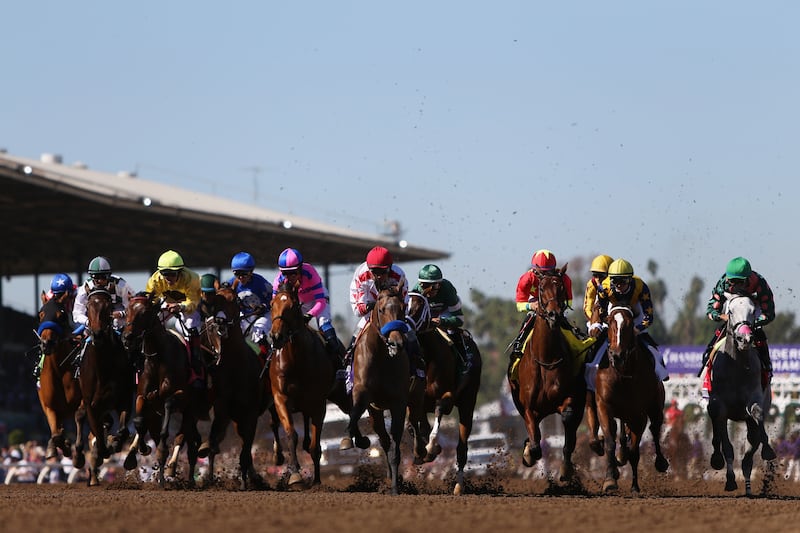In Ireland, we’re no strangers to forfeiting the future by hanging onto the past so US racing’s dirt dilemma is recognisable from across the pond. Persevering with dirt as its main surface satisfies tradition. It also risks the sport’s long-term viability.
Racing in America has been fighting a reputational rearguard action for years. Light-touch regulation, particularly with drugs, has produced widespread popular perception of a heartless industry with animal welfare low down the pecking order of priorities.
Being forced to employ counter arguments about perception not corresponding with reality are too often the opening shots of a losing battle. At the very least, racing’s transatlantic brand is unfashionable. At worst, if it impacts public consciousness at all, it can be through a prism of cruelty.
That’s the context in which the recent prestigious Saratoga meeting in upstate New York was marred by a pair of particularly sickening incidents.
READ MORE
The filly Maple Leaf Mel was leading the field and looked a certain winner of the Grade One Test Stakes when sustaining a dire leg injury just metres from the finish-line. She hit the ground and was quickly euthanised.
Last Saturday, just three weeks after the Maple Leaf Mel incident, the flying sprinter New York Thunder was clear inside the final furlong of the Grade One Allen Jerkins Stakes when his front left shattered. He too had to be euthanised.
Even watching both races live from the other side of the Atlantic, they were upsetting incidents. Looking at all that power and speed dissolve so catastrophically could make even the strongest stomach queasy. Particularly unsettling though were the uncanny similarities.
The statistical odds on two such occurrences happening in top-flight races on the one track on two of the biggest programmes of the season just three weeks apart were massive. It isn’t supposed to happen in flat racing, but presumption got dashed in front of a national TV audience.
It didn’t happen in isolation either. The deaths of a dozen horses at Churchill Downs earlier this year included two on Kentucky Derby day, simultaneously both the sport’s biggest shop window and a rare and increasingly uncomfortable date under a broader public microscope.

The potential threat of such focus got underlined at the high-profile Santa Anita track in Los Angeles in 2019 when 30 horses lost their lives. It was an unstainable rate of attrition that prompted calls for racing to be banned in California and not just from extremist groups either.
The result has been a significant tightening up of rules in relation to medication and pre-race veterinary inspections. They have produced significant statistical improvements at the main California tracks and elsewhere.
Racing is never risk free, but it must be made as safe as possible, and self-interest is bound up in that being seen to be the case. And that means there is a fundamental issue around how the majority of American racing takes place on dirt.
Historically, it was a renewable and easy to maintain surface for horses based at tracks to work and race on, unlike in Europe where turf predominates, and horses are trained separately. The advent of all-weather synthetic alternatives though opened a viable third way.
It’s a decade and a half since it looked like the US might embrace that option. The California tracks in particular tore up the dirt, replacing it with various mixes of wax coated sand, fibres and rubber that offers a different but more forgiving challenge when it comes to musculoskeletal problems.
It was no panacea. Synthetic brings its own problems in terms of expense and maintenance. But despite the beneficial welfare evidence, within a few years the trend was back to dirt.
Trainers, either through habit or suspicion, wanted to get back to the old surface. Bettors didn’t appear to like the all-weather for punting. The all-important betting ‘handle’ was affected. Last year that reached over $12 billion. It was felt the sums didn’t add up, so it was back to the past.
But there is one stark tot US racing eventually must reckon with and that is overwhelming evidence about how dirt produces a casualty rate three times higher than the all-weather.
With the sport staring down the barrel of an existential crisis, how sustainable is it to ignore that bottom line. How much harder is it going to be to stand over scenes such as at Saratoga on the basis that trainers and punters find it easier to profit by sticking with the tried and increasingly distrusted.
Injuries unfortunately occur on all surfaces. But the evidence increasingly suggests dirt statistically sticks out in terms of the toll taken on horses, particularly since increasing attention is being given to medication and pre-race veterinary checks.
Public scrutiny of animal-based sports is only going to increase everywhere, and the US at least has the option of taking the initiative in one area by switching focus to a surface that’s more forgiving to its central participants.
It would be an uncomfortable, divisive, and expensive step in the short-term. But it’s one that many leading figures in the sport acknowledge is eventually likely to happen anyway since worrying about tradition is futile if you’re already history.
Something for the Weekend
SIOUX SPIRIT (3.25) can be unpredictable, but she drops to the minimum distance for a handicap at Navan on Saturday. Having won her maiden over course and distance this time last year the move could pay off.
Horses for courses fans will be all over LADY TILBURY (4.20) if she lines up in Sunday’s Abergwaun Stakes at Tipperary. The filly is unbeaten in three course and distance starts and appears to be admirably versatile when it comes to ground conditions.















